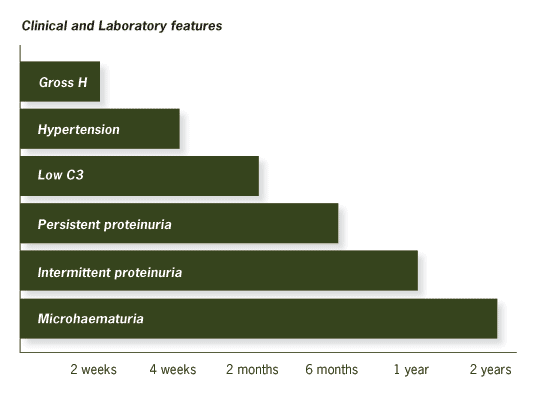In this article 
View / Download pdf version
of this article
In her UPFRONT article on infectious disease patterns (BPJ Issue 5 p4),
Professor Diana Lennon noted the fact that Post-streptococcal glomerulonephritis remains an issue in the upper north
island. This article explores its recognition and management.
Post-streptococcal glomerulonephritis persists as a problem in the upper North Island
Although rare, acute post-streptococcal glomerulonephritis (APSGN) is the most common glomerulonephritis affecting children1,2 particularly
those aged 2-12 years.
APSGN is typically a complication of group A streptococcal infection, usually originating from the skin (impetigo, infected
scabies) or occasionally, the throat. It was first recognised in the 18th century associated with the convalescence period
of scarlet fever.3 There are links today with overcrowded living conditions, low socio-economic status and
areas of close contact e.g. schools and daycare centres. Countries with tropical climates, where skin infections are common,
have higher incidence.3 In New Zealand, the upper North Island has the highest rates.
Clinical features vary with severity of the illness
There is a latent period between the streptococcal infection and the onset of APSGN - generally 3-4 weeks after skin
infection and 1-2 weeks after throat infection, so history taking needs to reflect this.
Presenting symptoms vary, depending on the severity. The classic clinical features are gross haematuria (30-50%)1,
oedema (60-70%)3 and hypertension (60-80%)1,3 but cases may range from those with asymptomatic microscopic
haematuria, who never reach medical attention, up to the 5% who have hypertensive encephalopathy with seizures, confusion
and coma.1 The dark urine, typical of the condition, may not be noticed by children. Patients may report general
malaise, anorexia, nausea, vomiting, headache or pain in the abdomen or back.2
On examination, signs are related primarily to volume overload - facial oedema, especially periorbital, generalised
oedema or even signs of congestive heart failure (raised JVP, enlarged liver, crepitations in lung bases). Patients may
be pale and could have residual signs of the contributing skin infection. BP should be checked.
Urinalysis can show frank blood, red cell casts, leucocytes and proteinuria. Throat swabs are unhelpful as they are
rarely positive.1 Further lab tests may show raised antistreptolysin-O (ASO), decreased complement levels,
increased urea and mild normochromic, normocytic anaemia due to haemodilution.1,2,3
APSGN is usually self limiting but supportive care and careful follow up are required
There is no specific treatment. APSGN is self-limiting - supportive care is needed with the major aims being to control
oedema and hypertension, if present. Salt and water restriction may be beneficial but referral to hospital may be required
for accurate fluid and electrolyte management, and treatment of hypertension with medication (iv frusemide, isradapine,
labetalol or others).1,3
Antibiotics can be given to reduce infectivity but they do not help in the actual treatment of APSGN.1 Family
members or other contacts are sometimes given prophylactic antibiotics.
The majority of children will recover spontaneously over 2-3 weeks with resolution of all abnormal symptoms and signs
(see Figure 1). Microscopic haematuria can, however, take up to 2 years to resolve.1 Chronic renal failure
is a rare complication in children but it is suggested that urinalysis and BP be rechecked at 3-6 monthly intervals.
Figure 1: Time course to resolution of APSGN1
 |
| C3 = Complement Protein, Gross H = Gross Haematuria |
References
- Wong W. Starship Children's Health Clinical Guideline. Sept 2005. Available on line at
www.starship.org.nz Accessed
July 2007.
- Bane-Terakubo TM. Nephritic Syndrome, Chapter XIII.1. Case Bases Pediatrics for Medical Students and Residents. Hawaii.
Dept of Pediatrics, Univeristy of Hawaii John A. Burns School of Medicine. 2002.
- Geetha D. Glomerulonephritis, Poststreptococcal. 2006. Available on line at
http://www.emedicine.com/med/topic889.htm Accessed
July 2007